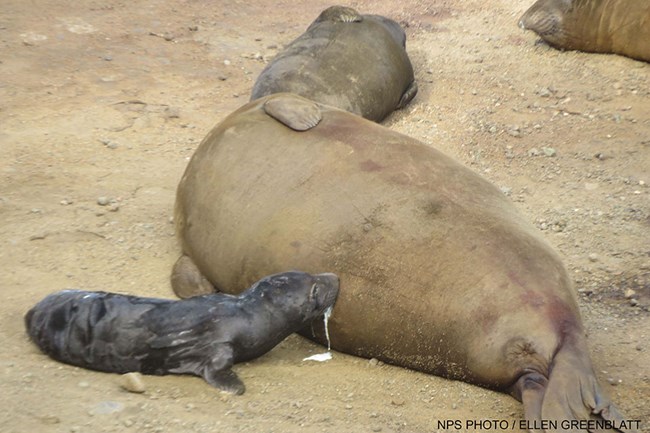Part of a series of articles titled Elephant Seal Tales.
Article
February: Mating and Impregnation – It's Complicated!

What conclusions might you draw?
After you see the complete video of this attempted mating later in the article, return to this photo and see if your conclusions are the same.
After the domestic month of January, primarily dedicated in the elephant seal world to the cows giving birth to and nursing their pups, February is a wild month for elephant seal bulls and the cows they are pursuing. The pursuit and the mating are neither delicate nor always mutually agreeable.

The bulls have been ready and waiting to mate, preparing themselves since hauling out onto Point Reyes beaches in December. Even after battling each other for primacy as an alpha male, they have continued to jockey for position as they waited first for the cows to arrive, then for them to give birth, then to nurse and wean their pups, and finally to enter estrus when they can be impregnated. But sometimes the bulls, both alpha males and less dominant and subadult males, do not wait as the urgent instinct to mate and to impregnate a cow takes over even before a cow has entered estrus, even before she is receptive, even as she is nursing her pup.
Descriptive Transcript
A female elephant seal and her pup lay on a beach made up of a mix of sand and rock. In the foreground, the pink, calloused chest and nose of an elephant seal bull are visible. The pup attempts to nurse on mom. The bull raises his head and begins to galumph over to the pair as mom looks on warily. She wriggles, throws sand and begins to vocalize. She hastily scoots away as the bull gives chase. He catches her and bites her neck as she continues to make attempts at escape.
- Duration:
- 40.642 seconds
A 40-second-long video of an adult bull elephant seal pursuing and attempting to mate with an adult female elephant seal that is still nursing its pup. Video taken on January 23, 2021.
The resulting matings, both successful and unsuccessful, are sometimes difficult for visitors to watch, especially if they have spent the previous weeks witnessing cows nurse their ever-fattening and often vocalizing dark-furred pups.
Although statistics show that the peak of mating occurs right around Valentine's Day, there is nothing we humans would identify as romantic about the coupling. The whole interchange is rapid and can appear brutal to park visitors.
Peggy McCutcheon, longtime Winter Wildlife Docent, told of introducing her stepdaughter, Hannah Rouley Bowick, to the world of elephant seal mating. (Hannah went on to be a docent herself for several years.) As Peggy explained to Hannah on her first visit, "There is no wining and dining." Instead, as pioneering elephant seal expert Burney LeBoeuf described, "Male courtship is usually direct, aggressive and persistent." Peggy went a little further in her down-to-earth, unscientific description, "It almost seems like assault," she said, before acknowledging that she might be anthropomorphizing, or assigning human values and characteristics to the elephant seals.
Still, the docents have their work cut out for them when they are explaining mating to visitors who are, for the first time, witnessing elephant seal copulation attempts.
Descriptive Transcript
A large bull elephant seal lies directly adjacent to a smaller female elephant seal on a hard sand beach. The bull moves directly to the side of the cow, places his flipper over her back and bites her neck. He tries to leverage his considerable weight advantage, using his head and upper body to pin down the less-than-receptive cow. The cow can and does resist by wriggling, vocalizing, and using her flipper to throw sand on the bull as she does not appear receptive to mating.
- Duration:
- 22.456 seconds
A 22-second-long video of an adult bull elephant seal attempting to mate with an unwilling adult female elephant seal. Video taken on January 23, 2021.
As the video above (from which the still photo at the top of the article comes) shows, the bull moves directly to the side of the cow and, with no preliminaries, places his flipper over her back and bites her neck. He can leverage his considerable weight advantage, using his head and upper body to pin down a less-than-receptive cow, but even then, a bull is not always successful. The cow can and does resist by wriggling, vocalizing, and using her flipper to throw sand on the bull if she is not receptive to mating.
The loud protests of the cow signal to nearby males that a copulation attempt is underway, and a more dominant male may interrupt the bull who is mounting the cow, increasing the possibility that her egg will be fertilized by a genetically superior bull, producing a more viable pup. But the bull can be distracted from copulating in the moment by the need to defend the rest of his harem from the approach of a competing male. As we said, mating—it's complicated!
In addition, as Sue Van Der Wal, who has been a Point Reyes volunteer for decades, noted another aspect of the harshness of the whole mating process: "A bull, who can move at six miles per hour on land in a burst, can, without even knowing, crush or even kill a pup as he is pursuing a cow" or, as in this video below, trying to get away from the alpha male who is defending the beach. Pups getting killed is, however, mercifully rare!
Descriptive Transcript
A large dark colored elephant seal male galumphs across a rocky beach. In his path, are a lighter colored female and her jet black pup. On route, the male tramples the pup, as the female squawks in alarm. The male approaches another female and pup, this time knocking the pup over and causing it to roll out of the way.
- Duration:
- 11.211 seconds
An 11-second-long video of an adolescent bull elephant seal trampling an elephant seal pup. Video taken on January 30, 2021.
Bulls continue their mating attempts until all the females have weaned their pups and have taken off for their two-month feeding voyage. Visitors are often puzzled, even distressed, and ask docents, "But don't the cows teach their pups to swim and hunt before they leave?" The answer is an unequivocal NO. Once the cows have given birth and nursed their pups, their "parental" responsibilities end, and the pups are on their own to learn how to survive. The cows' last task before leaving land is not to launch their pups into the next stage of their lives—it is to mate. Although alpha males are responsible for the majority of successful mating, the less dominant males sometimes intercept and mate with cows as they leave the harem and head into the sea. As they depart, females are receptive to "last-minute" mating attempts because such receptivity, assert experts Sarah Mesnick and Burney Le Boeuf, "'buys safe passage'…and is an effective means of reducing…the probability of injury; a male has no need to restrain a receptive female with blows, and should the most dominant male in the area copulate with a departing female, he frequently escorts her to sea and defends her." In other words, cows continue to be the object of bulls' mating attempts until the final moment bulls can access them.
The cows mate about a month after they have given birth, and then become pregnant again. So, does that mean that cows are pregnant almost all the time?
Well, sort of.
Let me explain: The cows neither eat nor drink during the whole time they are on land giving birth to and nursing their pups, and their body weight drops by more than 40% during that month. So, they need to feed deeply at sea and replenish themselves before they start the whole cycle of pregnancy again.
But since their egg has already been fertilized during mating on land, an extraordinary phenomenon called delayed implantation takes over.
Here's how delayed implantation works. When the cows copulate as they are finishing nursing their pups, often mating with multiple partners, their egg is fertilized. They are indeed technically pregnant with a fertilized blastocyst floating around in their uterus. But, because their bodies are so depleted, both from nursing their pups and from fasting, they need to bulk up again before the blastocyst implants and begins to develop. As a result, the blastocyst floats in the uterus for several months before implanting in the uterine wall and beginning development. So, though gestation lasts for 11 months, the actual development of the pup fetus occurs over seven months after the delayed implantation of the blastocyst into the uterine wall.
Although some adult females arrive in March to molt, we won't get to see the adult cows who have just given birth until April or May when they return to molt. (Molt? What’s that? Return for our last chapter of Elephant Seal Tales to learn more!) In the meantime, the newly-weaned pups are left on the beach to fend for themselves.
Teaser for our next and last chapter of Elephant Seal Tales:
What happens to the weaned pups when the cows leave?
How do ecologists and rangers tag and track elephant seals?
Where do bulls and cows go when they leave?
What is "molting," and who molts?
Because the pandemic is keeping Point Reyes National Seashore Docents from doing what they love best—interacting and explaining seals' behavior to the public—upcoming articles will attempt to provide month-to-month information and reflections on what all the activity means, including more anecdotes and interpretation by volunteers!

Be sure to check back for each update. And, if you find the volunteers' on-the-scene anecdotes tantalizing, visit our Point Reyes National Seashore's Volunteer page to learn more about volunteering and making a difference!
By Ellen Greenblatt, Point Reyes National Seashore Volunteer
Please note: Disrupting behavioral patterns of seals is prohibited. Please adhere to all elephant seal protection closures, and stay at least 25 feet away from seals outside of the protection closures. Check out these seal viewing tips for more information.
Last updated: September 4, 2021
